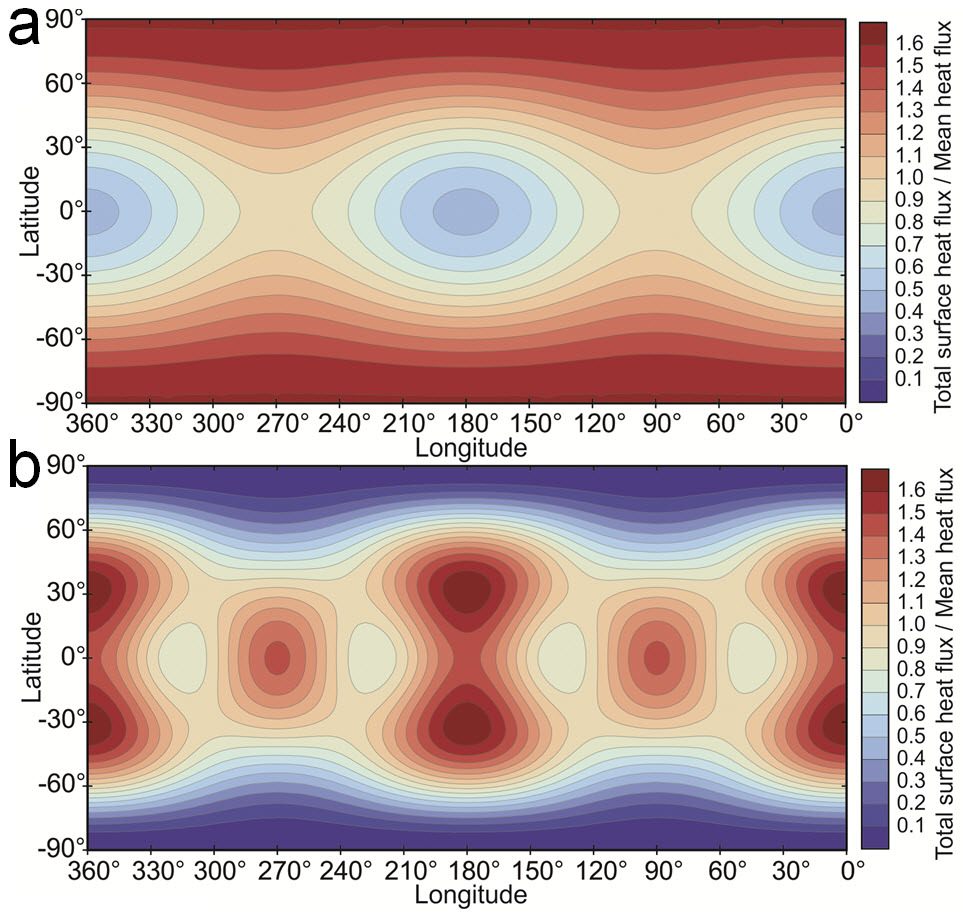New images from NASA’s Juno spacecraft make Io’s nature clear. It’s the most volcanically active world in the Solar System, with more than 400 active volcanoes. Juno has performed multiple flybys of Io, and images from its latest one show an enormous hotspot near the moon’s south pole.
Juno was sent to Jupiter to study the giant planet, but that primary mission ended, and NASA extended the mission. Currently, it is performing flybys of three of the Galilean moons: Ganymede, Europa, and Io. We’ve reported on Juno’s Io flybys previously.
In its latest flyby, the orbiter imaged a volcanic hotspot on the moon’s south pole larger than Lake Superior. The images are from Juno’s JIRAM (Jovian Infrared Auroral Mapper) instrument. According to NASA, the hot spot’s eruptions are six times more energetic than all of Earth’s power plants and its radiance measured well above 80 trillion watts.
“The data supports that this is the most intense volcanic eruption ever recorded on Io.”
Alessandro Mura, Juno co-investigator, National Institute for Astrophysics in Rome
“Juno had two really close flybys of Io during Juno’s extended mission,” said the mission’s principal investigator, Scott Bolton of the Southwest Research Institute in San Antonio. “And while each flyby provided data on the tormented moon that exceeded our expectations, the data from this latest — and more distant — flyby really blew our minds. This is the most powerful volcanic event ever recorded on the most volcanic world in our solar system — so that’s really saying something,” Bolton said in a NASA press release.

Io is volcanic because of tidal heating. Io is the innermost of Jupiter’s four Galilean moons and is roughly the same size as Earth’s Moon. However, it’s very close to the much larger Jupiter, follows an elliptical orbit, and completes one every 42.5 hours. Jupiter is roughly 300 times more massive than Earth. That means that Jupiter dwarfs Io, and as the moon orbits the gas giant, the gas giant has its way with it. Jupiter stretches and pulls on the little moon, causing it to flex and change shape, creating internal heat. The other Galilean moons also contribute.

The heat is enough to melt the moon’s interior into molten rock. The tidal flexing creates an endless series of plumes and ash that make the moon the most volcanically active body in the Solar System. The ash also paints the small moon’s surface.
During its extended mission, Juno flies past Io on every other orbit, meaning the images can track any changes on the surface. During a previous flyby on February 3rd, 2024, Juno came within 1,500 km (930 mi) of the moon’s surface.

During this latest flyby, it was much further away. It only got to within about 74,400 kilometres (46,200 mi) of the moon, and its JIRAM instrument was pointed at the south pole.
“JIRAM detected an event of extreme infrared radiance — a massive hot spot — in Io’s southern hemisphere so strong that it saturated our detector,” said Alessandro Mura, a Juno co-investigator from the National Institute for Astrophysics in Rome. “However, we have evidence what we detected is actually a few closely spaced hot spots that emitted at the same time, suggestive of a subsurface vast magma chamber system. The data supports that this is the most intense volcanic eruption ever recorded on Io.”
This feature, which has yet to be named, dwarfs Loki Patera, the lake of lava detected in 2015 during a rare orbital alignment between Io and Europa. Loki Patera is 202 kilometres (126 mi) in diameter, covers 20,000 sq km (7,700 sq mi), and was the largest volcanic feature found on Io until these new observations revealed the hot spot in the south polar region. The new hot spot covers 100,000 sq km (40,000 sq mi).
Juno also captured images of the hot spot region with its JunoCam imager. Though the images were captured from different distances and are somewhat grainy, they still reveal surface colour changes near the south pole. Scientists know that these colour changes are associated with hot spots and volcanic activity.

Juno will fly by Io again on March 3rd. It will examine the hotspot again and try to discern any more surface changes. Massive eruptions like this one leave their mark on the surface, and these marks can be long-lived. The eruptions can leave behind pyroclastic deposits, lava flows, and sulphur-rich deposits from plumes that colour the moon’s surface. It’s also possible that Earth-based observations can probe the same region.
Scientists have unanswered questions about Io’s extreme volcanic activity. They know tidal heating is the root cause, but they don’t have a clear understanding of how the heat moves through Io’s interior. They also don’t know if the moon has a global, subsurface lava ocean, though some studies suggest it does. They also wonder about the relationship between the volcanoes and Jupiter’s magnetosphere, where much of the material from the volcanoes goes. The long-term evolution of Io’s volcanic activity is also shrouded in mystery. How has it changed over time?

Answers to these questions will also tell scientists about volcanism on other worlds.
“While it is always great to witness events that rewrite the record books, this new hot spot can potentially do much more,” said Bolton. “The intriguing feature could improve our understanding of volcanism not only on Io but on other worlds as well.”
The post Juno Sees a Massive Hotspot of Volcanic Activity on Io appeared first on Universe Today.
from Universe Today https://ift.tt/vZeQNh6
via IFTTT
Comments
Post a Comment